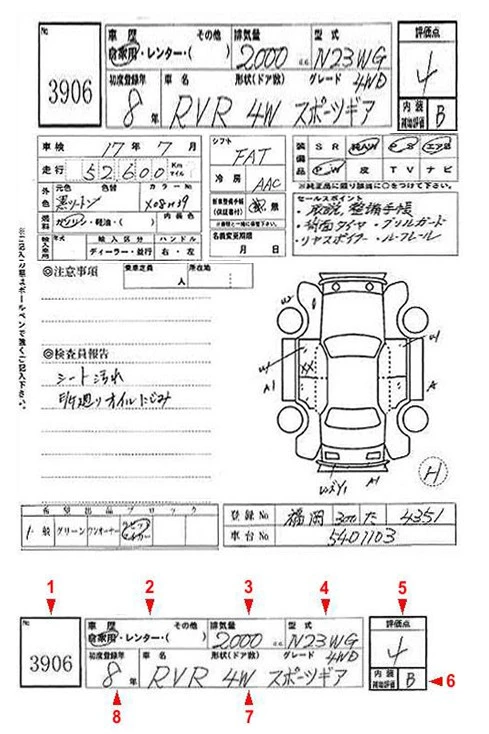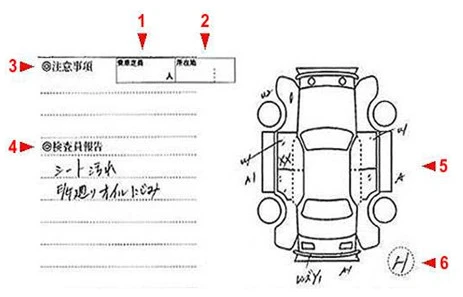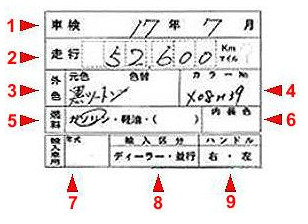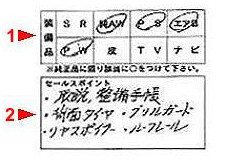The auction sheet is a kind of technical condition map of the car. It was introduced to facilitate the transfer of information for trading. An expert evaluates the car and puts standard marks in specific columns of the sheet. What is written on the auction sheet? See the description.

- 1 – lot number.
- 2 – vehicle history: the car was owned by a private individual, leased, or there was some other option. These three options are separated by dots in the middle of the line. In this case, the position indicating that the car was used by a private individual is circled.
- 3 – engine displacement in cubic centimeters.
- 4 – body type model.
- 5 – auction estimate.
- 6 – interior condition rating. On most Japanese auctions, the exterior condition and interior condition are rated separately. Latin letters are used to rate the interior condition:
- A – excellent condition
- B – minor dirt
- C – acceptable dirt or minor cigarette burns
- D – dirty interior, stains or many cigarette burns.
- 7 – from left to right, the model name (in this case, RVR), the number of doors, and the modification name are written.
- 8 – the year of the first registration according to the Japanese calendar. To convert to the European calendar system, add 88. In this case, the model is from 1996.

- 1 – the number of seats in the car.
- 2 – the total number of seats in the car.
- 3 – positive comments that should be paid attention to.
- 4 – negative comments that should be paid attention to.
- 5 – car body diagram with identification of body defects.
- 6 – condition of tire tread, from 1 to 10 (10 – excellent; 1 – heavily worn).

- 1 – This column indicates the block of lots in which this car will be sold. It depends on the evaluation and remarks of the expert.
- 2 – The registration number of the car.
- 3 – The full body number.

- 1 – transmission type: AT – automatic transmission FAT/FA – floor automatic transmission. CA – column automatic transmission MT – manual transmission. F5, F6, F4, etc. – floor manual transmission. The number indicates the number of gears. C5, C4, etc. – column manual transmission. The number indicates the number of gears. SQ – sequential gearbox (tiptronic/steptronic)
- 2 – air conditioner. AC – standard air conditioner, AAC – automatic air conditioner/climate control.
- 3 – presence or absence of service book. The character on the left is circled – the book is present.
- 4 – expiration date of the auction sheet (month/day).

- 1 – the date of the next mandatory vehicle inspection in Japan, indicated in year/month format. In this sheet, it is July 2005 (17th year, 7th month).
- 2 – mileage, indicated in either kilometers or miles. In the right part of the column, either “Km” (kilometers) or “miles” (written in katakana below Km) is circled. If the vehicle doesn’t have a service book, the mileage is considered questionable (a question mark is marked in the right part of the column).
- 3 – the color of the vehicle, written in kanji. If the vehicle was repainted, the new color is written after an arrow.
- 4 – the color code of the vehicle.
- 5 – the type of fuel. From left to right, it shows gasoline, diesel, and other. In this case, it is “gasoline.”
- 6 – the color of the interior of the vehicle.
- 7 – the length of use of the vehicle.
- 8 – the car dealers’ column. If there are notes here, it means that the car was purchased through a dealership.
- 9 – the position of the steering wheel. The first kanji indicates that the steering wheel is on the right, and the second one on the left. By default, it is assumed to be on the right.

- 1 – Additional equipment of the car: SR – sunroof. AW – alloy wheels. PS – power steering. エアB – airbags. PW – power windows. (カワ) 本革シート – leather seats. TV – television. ナビ – navigation system. Checked positions of the equipment are circled. This model has alloy wheels, power steering, airbags, and power windows.
- 2 – Additional equipment not listed above. In other words, any additional options that have been deemed necessary to add to the list.
